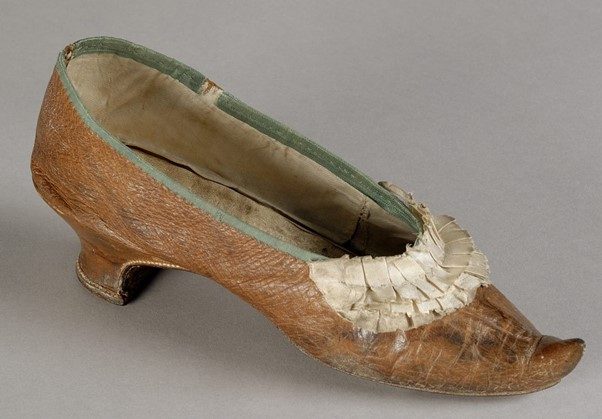A Glass Slipper

This is not Cinderella’s slipper lost on her run down the steps from the prince’s palace at midnight.
This is Marie Antoinette’s slipper lost on her stumble up the steps to the guillotine at midday.
On 16 October 1793, it was bought on the spot by Monsieur le Comte de Guernon-Ranville, and was given by his family to the Musée des Beaux Arts de Caen soon after the restoration of the Monarchy.
Le petit soulier is battered and bent – a well worn shoe: the Queen had had few possessions during the 14 month imprisonment prior to her execution.
Today, there is a brisk on-line trade in “well worn” shoes, a demand largely emanating from America and France. They sell better with the feet (and legs) displayed, even better with “a full body shot”. More punters want them to be smelly.
Fetishists will pay substantially more for smelly female shoes. Although sites will stipulate that they must be adequately cleansed, it is not supposed that they are inspected. If you happen to run out of used shoes to sell, you are advised to do a deal with a charity shop for job lots of “unsaleable items”.
So far, so disgusting, I suppose.
But, smelly shoes will have been infected at some stage, as likely as not. Fungi hang around interminably in the form of hard-shelled spores which will burst into activity when wetted and warmed. They can be revivified from earth left undisturbed for hundreds of years.
At school, we were told to report our foot and groin infections to Matron. She painted our affected parts with gentian violet (not made from violets), a potent antifungal. This violent synthetic colour marked us out, and would last until the last flake of skin was shed.
Gentian violet had originally been developed in the 1880s for the microscopic differentiation of bacteria by “staining”, and was used to great effect by such as Hans Christian Gram and Paul Ehrlich, famous names probably still familiar to modern medical students.
Needless to say, there are millions of fungal species waiting for the opportunity to infect humans, but our inherently sophisticated immune systems are well able to fend off the huge majority. Indeed, it is this immunity that has ensured the world dominance of mammals. However, the “immunocompromised”, especially those being treated for cancers or AIDS, remain uniquely vulnerable. With the increase in use of cytotoxic agents, the systemic invasion of dangerous fungi is becoming relatively commonplace. (1)
For the rest of us, the fungi largely live on, and off, our skins, hatching from their spores in warm, dark, damp places – between toes, under larger breasts, in toenails, in groins, between buttocks, under foreskins. The infections will tend to attack people who do not change their sweaty socks or underwear, who go to public baths, and, fancy that, people who wear old, especially tight, shoes. Shared towels spread them around. Thrush (candidiasis) can invade mouths and vaginas. Diabetics are more likely to be affected.
Obviously, hot summers do not help. With the warming effect of climate change, fungal infections will proliferate, and become a somewhat more severe problem.
With GP’s taking less interest in face-to-face consultations, it would be best to look after ourselves more effectively. There is much we can do –
- * Firstly, do not get fat, or lose weight if you are. Fungi love nooks, crannies and gullies – what doctors call “intertriginous zones” – under the folds.
- * Wash all over daily with scent-free soap. Dry thoroughly.
- * Wear loose-fitting clothes made from cotton. No lycra budgie-smugglers – boxers preferred. No nylon socks.
- * Wear well-fitting shoes made from leather or breathable material.
- * Change your cotton socks and underwear daily.
- * Wash your clothes, towels and bed linen frequently.
- * Do not share towels, clothing, brushes, combs.
- * Wear crocs or similar in public swimming pools and saunas.
- * Draw back the foreskin and gently wash the glans.
If you sweat profusely, you will invite infections for all the reasons mentioned above, but also sweat reduces the acidity of the skin: fungi hate acidity. Applying acidified talcum powder after washing helps soak up sweat and re-acidify the skin. This is useful for feet – somewhat messy for anywhere else! There are plenty of antifungal powders available over the counter.
Obesity, and its close companion diabetes, create an ideal environment for fungi. Don’t go there – for many very good reasons.
Obviously, fungal infections can be venereal. Use a condom if in doubt.
Antibiotics, steroids (such as prednisolone) and chemotherapy drugs can cause chronic recurrence of fungal infections.
Anti-fungal creams, sprays, lotions and powders are freely available over the counter. If they do not work, you should not avoid seeing a doctor. Your diagnosis might be wrong.
When seen, a doctor will prescribe oral treatments which are slow to work, especially if the infection is in slow growing toenails. Nail lacquers are very slow to work and might not work at all.
Treating fungal infections of toenails is important. When affected the nail plate will become detached from the pulp and form a scoop for all the bacteria we wade through. Some virulent bacteria can spread up the leg all too quickly, and intravenous antibiotics might be necessary.
References
PMID 25367975 – The Spectrum of Fungi That Infects Humans
****
Britain had beaten the French during the Seven Years’ War, a contest for world domination. The French sought retribution by aiding the Americans in their War of Independence by supplying gunpowder and shot at a massive cost. The cost was so great as to precipitate the French Revolution and Queen Marie Antoinette’s demise, along with at least 40,000 other “enemies of the people” during the Reign of Terror, which lasted just ten months, 5 September 1793 to 27 July 1794.
For Robespierre read Putin, perhaps?


